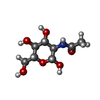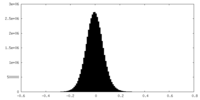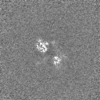[English] 日本語
 Yorodumi
Yorodumi- EMDB-42905: Cryo-EM structure of mouse type II OSM receptor complex: model fo... -
+ Open data
Open data
- Basic information
Basic information
| Entry |  | |||||||||
|---|---|---|---|---|---|---|---|---|---|---|
| Title | Cryo-EM structure of mouse type II OSM receptor complex: model for assembly core region | |||||||||
 Map data Map data | ||||||||||
 Sample Sample |
| |||||||||
 Keywords Keywords | cytokine signaling / OSM / gp130 / OSMR / CYTOKINE / CYTOKINE-RECEPTOR complex | |||||||||
| Function / homology |  Function and homology information Function and homology informationoncostatin-M receptor binding / oncostatin-M receptor activity / meiotic nuclear division / IL-6-type cytokine receptor ligand interactions / MAPK3 (ERK1) activation / MAPK1 (ERK2) activation / Interleukin-27 signaling / leukemia inhibitory factor receptor activity / interleukin-6 receptor activity / interleukin-6 binding ...oncostatin-M receptor binding / oncostatin-M receptor activity / meiotic nuclear division / IL-6-type cytokine receptor ligand interactions / MAPK3 (ERK1) activation / MAPK1 (ERK2) activation / Interleukin-27 signaling / leukemia inhibitory factor receptor activity / interleukin-6 receptor activity / interleukin-6 binding / Interleukin-6 signaling / Interleukin-35 Signalling / oncostatin-M-mediated signaling pathway / negative regulation of meiotic nuclear division / oncostatin-M receptor complex / interleukin-27 receptor activity / ciliary neurotrophic factor receptor binding / ciliary neurotrophic factor receptor complex / interleukin-6 receptor complex / negative regulation of hormone secretion / interleukin-11-mediated signaling pathway / interleukin-6 receptor binding / regulation of Notch signaling pathway / positive regulation of adaptive immune response / positive regulation of astrocyte differentiation / intestinal epithelial cell development / peripheral nervous system development / cell surface receptor signaling pathway via STAT / glycogen metabolic process / interleukin-6-mediated signaling pathway / positive regulation of Notch signaling pathway / cytokine binding / behavioral response to pain / protein tyrosine kinase activator activity / positive regulation of osteoblast differentiation / coreceptor activity / positive regulation of T cell proliferation / cytokine activity / positive regulation of apoptotic signaling pathway / cytokine-mediated signaling pathway / cell body / response to heat / scaffold protein binding / negative regulation of neuron apoptotic process / cell surface receptor signaling pathway / positive regulation of MAPK cascade / immune response / membrane raft / external side of plasma membrane / neuronal cell body / positive regulation of cell population proliferation / dendrite / signal transduction / positive regulation of transcription by RNA polymerase II / extracellular space / identical protein binding / plasma membrane Similarity search - Function | |||||||||
| Biological species |  | |||||||||
| Method | single particle reconstruction / cryo EM / Resolution: 3.46 Å | |||||||||
 Authors Authors | Zhou Y / Franklin MC | |||||||||
| Funding support | 1 items
| |||||||||
 Citation Citation |  Journal: Nat Commun / Year: 2024 Journal: Nat Commun / Year: 2024Title: Structures of complete extracellular assemblies of type I and type II Oncostatin M receptor complexes. Authors: Yi Zhou / Panayiotis E Stevis / Jing Cao / George Ehrlich / Jennifer Jones / Ashique Rafique / Mark W Sleeman / William C Olson / Matthew C Franklin /  Abstract: Oncostatin M (OSM) is a unique Interleukin 6 (IL-6) family cytokine that plays pivotal roles in numerous biological events by signaling via two types of receptor complexes. While type I OSM receptor ...Oncostatin M (OSM) is a unique Interleukin 6 (IL-6) family cytokine that plays pivotal roles in numerous biological events by signaling via two types of receptor complexes. While type I OSM receptor complex is formed by glycoprotein 130 (gp130) heterodimerization with Leukemia Inhibitory Factor receptor (LIFR), type II OSM receptor complex is composed of gp130 and OSM receptor (OSMR). OSM is an important contributor to multiple inflammatory diseases and cancers while OSM inhibition has been shown to be effective at reducing symptoms, making OSM an attractive therapeutic target. Using cryogenic electron microscopy (cryo-EM), we characterize full extracellular assemblies of human type I OSM receptor complex and mouse type II OSM receptor complex. The juxtamembrane domains of both complexes are situated in close proximity due to acute bends of the receptors. The rigid N-terminal extension of OSM contributes to gp130 binding and OSM signaling. Neither glycosylation nor pro-domain cleavage of OSM affects its activity. Mutagenesis identifies multiple OSM and OSMR residues crucial for complex formation and signaling. Our data reveal the structural basis for the assemblies of both type I and type II OSM receptor complexes and provide insights for modulation of OSM signaling in therapeutics. | |||||||||
| History |
|
- Structure visualization
Structure visualization
| Supplemental images |
|---|
- Downloads & links
Downloads & links
-EMDB archive
| Map data |  emd_42905.map.gz emd_42905.map.gz | 163.8 MB |  EMDB map data format EMDB map data format | |
|---|---|---|---|---|
| Header (meta data) |  emd-42905-v30.xml emd-42905-v30.xml emd-42905.xml emd-42905.xml | 19.2 KB 19.2 KB | Display Display |  EMDB header EMDB header |
| Images |  emd_42905.png emd_42905.png | 68 KB | ||
| Filedesc metadata |  emd-42905.cif.gz emd-42905.cif.gz | 6.6 KB | ||
| Others |  emd_42905_half_map_1.map.gz emd_42905_half_map_1.map.gz emd_42905_half_map_2.map.gz emd_42905_half_map_2.map.gz | 165 MB 165 MB | ||
| Archive directory |  http://ftp.pdbj.org/pub/emdb/structures/EMD-42905 http://ftp.pdbj.org/pub/emdb/structures/EMD-42905 ftp://ftp.pdbj.org/pub/emdb/structures/EMD-42905 ftp://ftp.pdbj.org/pub/emdb/structures/EMD-42905 | HTTPS FTP |
-Validation report
| Summary document |  emd_42905_validation.pdf.gz emd_42905_validation.pdf.gz | 1.1 MB | Display |  EMDB validaton report EMDB validaton report |
|---|---|---|---|---|
| Full document |  emd_42905_full_validation.pdf.gz emd_42905_full_validation.pdf.gz | 1.1 MB | Display | |
| Data in XML |  emd_42905_validation.xml.gz emd_42905_validation.xml.gz | 15.1 KB | Display | |
| Data in CIF |  emd_42905_validation.cif.gz emd_42905_validation.cif.gz | 17.9 KB | Display | |
| Arichive directory |  https://ftp.pdbj.org/pub/emdb/validation_reports/EMD-42905 https://ftp.pdbj.org/pub/emdb/validation_reports/EMD-42905 ftp://ftp.pdbj.org/pub/emdb/validation_reports/EMD-42905 ftp://ftp.pdbj.org/pub/emdb/validation_reports/EMD-42905 | HTTPS FTP |
-Related structure data
| Related structure data |  8v2cMC  8v29C  8v2aC  8v2bC M: atomic model generated by this map C: citing same article ( |
|---|---|
| Similar structure data | Similarity search - Function & homology  F&H Search F&H Search |
- Links
Links
| EMDB pages |  EMDB (EBI/PDBe) / EMDB (EBI/PDBe) /  EMDataResource EMDataResource |
|---|---|
| Related items in Molecule of the Month |
- Map
Map
| File |  Download / File: emd_42905.map.gz / Format: CCP4 / Size: 178 MB / Type: IMAGE STORED AS FLOATING POINT NUMBER (4 BYTES) Download / File: emd_42905.map.gz / Format: CCP4 / Size: 178 MB / Type: IMAGE STORED AS FLOATING POINT NUMBER (4 BYTES) | ||||||||||||||||||||||||||||||||||||
|---|---|---|---|---|---|---|---|---|---|---|---|---|---|---|---|---|---|---|---|---|---|---|---|---|---|---|---|---|---|---|---|---|---|---|---|---|---|
| Projections & slices | Image control
Images are generated by Spider. | ||||||||||||||||||||||||||||||||||||
| Voxel size | X=Y=Z: 0.86 Å | ||||||||||||||||||||||||||||||||||||
| Density |
| ||||||||||||||||||||||||||||||||||||
| Symmetry | Space group: 1 | ||||||||||||||||||||||||||||||||||||
| Details | EMDB XML:
|
-Supplemental data
-Half map: #1
| File | emd_42905_half_map_1.map | ||||||||||||
|---|---|---|---|---|---|---|---|---|---|---|---|---|---|
| Projections & Slices |
| ||||||||||||
| Density Histograms |
-Half map: #2
| File | emd_42905_half_map_2.map | ||||||||||||
|---|---|---|---|---|---|---|---|---|---|---|---|---|---|
| Projections & Slices |
| ||||||||||||
| Density Histograms |
- Sample components
Sample components
-Entire : Mouse OSM in complex with gp130 and OSMR
| Entire | Name: Mouse OSM in complex with gp130 and OSMR |
|---|---|
| Components |
|
-Supramolecule #1: Mouse OSM in complex with gp130 and OSMR
| Supramolecule | Name: Mouse OSM in complex with gp130 and OSMR / type: complex / ID: 1 / Parent: 0 / Macromolecule list: #1-#3 |
|---|
-Macromolecule #1: Oncostatin-M
| Macromolecule | Name: Oncostatin-M / type: protein_or_peptide / ID: 1 / Number of copies: 1 / Enantiomer: LEVO |
|---|---|
| Source (natural) | Organism:  |
| Molecular weight | Theoretical: 20.645201 KDa |
| Recombinant expression | Organism:  |
| Sequence | String: ANRGCSNSSS QLLSQLQNQA NLTGNTESLL EPYIRLQNLN TPDLRAACTQ HSVAFPSEDT LRQLSKPHFL STVYTTLDRV LYQLDALRQ KFLKTPAFPK LDSARHNILG IRNNVFCMAR LLNHSLEIPE PTQTDSGASR STTTPDVFNT KIGSCGFLWG Y HRFMGSVG RVFREWDDGS TRSRR UniProtKB: Oncostatin-M |
-Macromolecule #2: Interleukin-6 receptor subunit beta
| Macromolecule | Name: Interleukin-6 receptor subunit beta / type: protein_or_peptide / ID: 2 / Number of copies: 1 / Enantiomer: LEVO |
|---|---|
| Source (natural) | Organism:  |
| Molecular weight | Theoretical: 70.033594 KDa |
| Recombinant expression | Organism:  |
| Sequence | String: QLLEPCGYIY PEFPVVQRGS NFTAICVLKE ACLQHYYVNA SYIVWKTNHA AVPREQVTVI NRTTSSVTFT DVVLPSVQLT CNILSFGQI EQNVYGVTML SGFPPDKPTN LTCIVNEGKN MLCQWDPGRE TYLETNYTLK SEWATEKFPD CQSKHGTSCM V SYMPTYYV ...String: QLLEPCGYIY PEFPVVQRGS NFTAICVLKE ACLQHYYVNA SYIVWKTNHA AVPREQVTVI NRTTSSVTFT DVVLPSVQLT CNILSFGQI EQNVYGVTML SGFPPDKPTN LTCIVNEGKN MLCQWDPGRE TYLETNYTLK SEWATEKFPD CQSKHGTSCM V SYMPTYYV NIEVWVEAEN ALGKVSSESI NFDPVDKVKP TPPYNLSVTN SEELSSILKL SWVSSGLGGL LDLKSDIQYR TK DASTWIQ VPLEDTMSPR TSFTVQDLKP FTEYVFRIRS IKDSGKGYWS DWSEEASGTT YEDRPSRPPS FWYKTNPSHG QEY RSVRLI WKALPLSEAN GKILDYEVIL TQSKSVSQTY TVTGTELTVN LTNDRYVASL AARNKVGKSA AAVLTIPSPH VTAA YSVVN LKAFPKDNLL WVEWTPPPKP VSKYILEWCV LSENAPCVED WQQEDATVNR THLRGRLLES KCYQITVTPV FATGP GGSE SLKAYLKQAA PARGPTVRTK KVGKNEAVLA WDQIPVDDQN GFIRNYSISY RTSVGKEMVV HVDSSHTEYT LSSLSS DTL YMVRMAAYTD EGGKDGPEFT FTTPKFAQGE IEEQKLISEE DLGGEQKLIS EEDLHHHHHH UniProtKB: Interleukin-6 receptor subunit beta |
-Macromolecule #3: Oncostatin-M-specific receptor subunit beta
| Macromolecule | Name: Oncostatin-M-specific receptor subunit beta / type: protein_or_peptide / ID: 3 / Number of copies: 1 / Enantiomer: LEVO |
|---|---|
| Source (natural) | Organism:  |
| Molecular weight | Theoretical: 82.357742 KDa |
| Recombinant expression | Organism:  Homo sapiens (human) Homo sapiens (human) |
| Sequence | String: EVLEEPLPLT PEIHKVSFQL KLQEVNLEWT VPALTHEELN MIFQIEISRL NISNTIWVEN YSTTVKREEA VRWNWTSDIP LECVKHFIR IRALVDDTKS LPQSSWGNWS SWKEVNAKVS VEPDKSLIFP KDKVLEEGSN VTICLMYGQN VYNVSCKLQD E PIHGEQLD ...String: EVLEEPLPLT PEIHKVSFQL KLQEVNLEWT VPALTHEELN MIFQIEISRL NISNTIWVEN YSTTVKREEA VRWNWTSDIP LECVKHFIR IRALVDDTKS LPQSSWGNWS SWKEVNAKVS VEPDKSLIFP KDKVLEEGSN VTICLMYGQN VYNVSCKLQD E PIHGEQLD SHVSLLKLNN VVFLSDTGTN INCQATKGPK RIFGTVLFVS KVLEEPKNVS CETRDFKTLD CSWEPGVDTT LT WRKQRFQ NYTLCESFSK RCEVSNYRNS YTWQITEGSQ EMYNFTLTAE NQLRKRSVNI NFNLTHRVHP KAPQDVTLKI IGA TKANMT WKVHSHGNNY TLLCQVKLQY GEVIHEHNVS VHMSANYLFS DLDPDTKYKA FVRCASANHF WKWSDWTQKE FSTP ETAPS QALDVWRQVW SENGRRIVTL FWKPLLKSQA NGKIISYNIV VENEAKPTES EHYCVWAPAL STNLSLDLQP YKIRI TTNN SMGASPESLM VLSNDSGHEE VKEKTIKGIK DAFNISWEPV SGDTMGYVVD WCAHSQDQRC DLQWKNLGPN TTSTTI TSD DFKPGVRYNF RIFERSVEHK ARLVEKQRGY TQELAPLVNP KVEIPYSTPN SFVLRWPDYD SDFQAGFIKG YLVYVKS KE MQCNQPWERT LLPDNSVLCK YDINGSETKT LTVENLQPES LYEFFVTPYT SAGPGPNETF TKVTTPDARS HML UniProtKB: Oncostatin-M-specific receptor subunit beta |
-Macromolecule #5: 2-acetamido-2-deoxy-beta-D-glucopyranose
| Macromolecule | Name: 2-acetamido-2-deoxy-beta-D-glucopyranose / type: ligand / ID: 5 / Number of copies: 3 / Formula: NAG |
|---|---|
| Molecular weight | Theoretical: 221.208 Da |
| Chemical component information |  ChemComp-NAG: |
-Experimental details
-Structure determination
| Method | cryo EM |
|---|---|
 Processing Processing | single particle reconstruction |
| Aggregation state | particle |
- Sample preparation
Sample preparation
| Buffer | pH: 7.5 |
|---|---|
| Vitrification | Cryogen name: ETHANE |
- Electron microscopy
Electron microscopy
| Microscope | FEI TITAN KRIOS |
|---|---|
| Image recording | Film or detector model: GATAN K3 BIOQUANTUM (6k x 4k) / Average electron dose: 40.0 e/Å2 |
| Electron beam | Acceleration voltage: 300 kV / Electron source:  FIELD EMISSION GUN FIELD EMISSION GUN |
| Electron optics | Illumination mode: FLOOD BEAM / Imaging mode: BRIGHT FIELD / Nominal defocus max: 2.6 µm / Nominal defocus min: 1.4000000000000001 µm |
| Experimental equipment |  Model: Titan Krios / Image courtesy: FEI Company |
 Movie
Movie Controller
Controller











 Z (Sec.)
Z (Sec.) Y (Row.)
Y (Row.) X (Col.)
X (Col.)




































